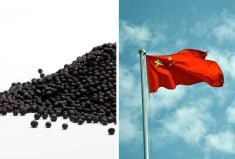The fall run remained in full swing at Manitoba cattle auction marts during the week ended Nov. 16, with large volumes and reasonably steady feeder prices at most yards.
About 16,500 cattle moved through the rings across the province during the week, with demand coming from all of the usual sources. Feeder steers 600 pounds and under were typically getting at least C$200 per hundredweight (cwt), with prices as high as C$250 to C$280 cwt for some of the lighter and higher quality animals.
Heifers were discounted by about C$20 to C$30 per cwt on average.
Read Also

U.S. livestock: Cattle fall sharply as Trump says he’s working to lower beef costs
Chicago cattle futures fell sharply on Friday after U.S. President Donald Trump said his administration was working to lower the…
In the slaughter market, good quality cows were generally selling anywhere from $50 to C$75 per cwt, while bulls were ranging from about C$80 to C$100 per cwt.
A shortage of feed in some areas was seeing more cows and bulls come to market than might otherwise at this time of year, which weighed on prices in those markets, according to Dave Nickel, of the Gladstone Auction Mart.
“This week we witnessed the largest weekly drop in cow prices in the post BSE era,” Winnipeg Livestock Sales said in their weekly market report. The Winnipeg commentary noted that cow prices were down by about C$10 to C$12 per cwt on the week, as “kill plants cannot keep up with the cows that are being flushed out of the system due to shortages of feed and heavy culling at this time.”
The futures in the United States also came under some pressure, which contributed to the softness for cows in the Manitoba auctions, according to Nickel.
On the feeder side, Nickel didn’t think there were any particular market moving factors on either side. “There are no big movers and shakers at this time, but it could break at any time,” said Nickel.
“The calves are coming in a little bit lighter,” said Nickel noting that the lack of grass in some areas was likely behind that.
He added that the plainer cattle were under more pressure, but the first cut calves were holding steady.
“Many feedlots are backed up with fat cattle that are awaiting kill and this is also hampering the calf market. With large volumes of calves moving at this time of the year buyers are very selective and large discounts are being made for stale or short cattle,” said the Winnipeg report. However, good grass weight steers and heifers were still trading with healthy demand.
U.S. feeder cattle futures fell to their softest levels since June early in the week, before uncovering support and correcting higher. Live cattle, meanwhile, held relatively range-bound during the week. News that Japan was considering lifting import restrictions on U.S. beef from cattle over 30 months of age provided some support for country’s prices.














